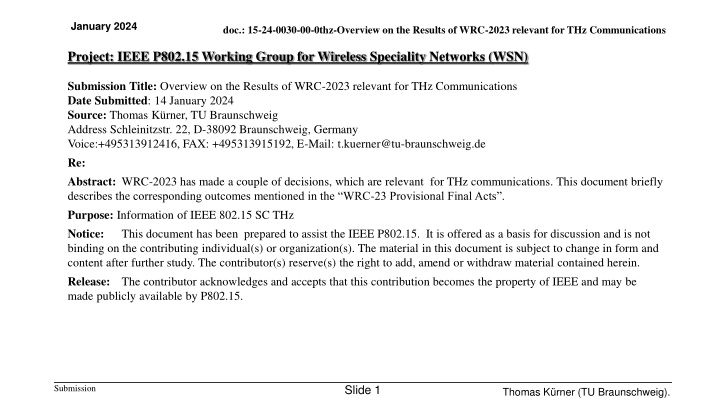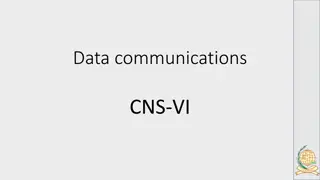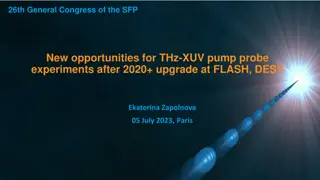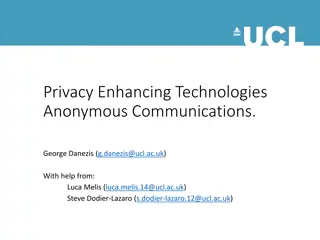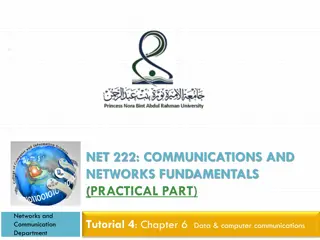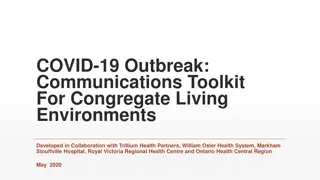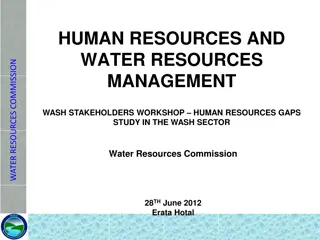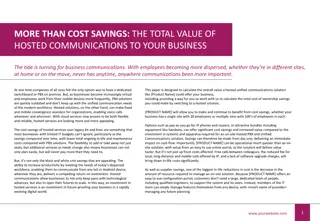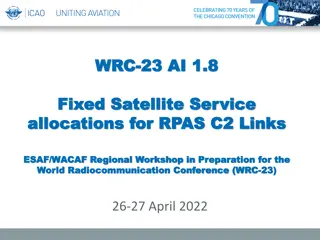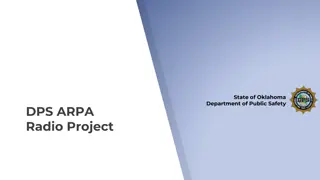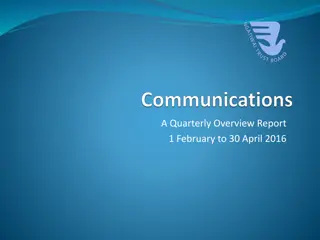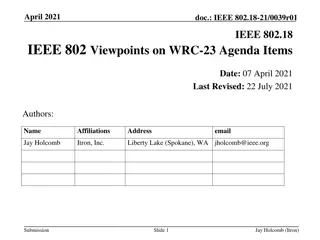Overview of WRC-2023 Results Relevant for THz Communications Project
WRC-2023 decisions impacting THz communications are outlined in this document submitted by Thomas Körner from TU Braunschweig. Changes in radio regulations, new allocations for Radio Location Services, and resolutions on passive and active service compatibility are highlighted, with potential new bands between 231.5 and 239.2 GHz discussed. The document serves as an informative basis for IEEE P802.15 SC THz.
Download Presentation

Please find below an Image/Link to download the presentation.
The content on the website is provided AS IS for your information and personal use only. It may not be sold, licensed, or shared on other websites without obtaining consent from the author.If you encounter any issues during the download, it is possible that the publisher has removed the file from their server.
You are allowed to download the files provided on this website for personal or commercial use, subject to the condition that they are used lawfully. All files are the property of their respective owners.
The content on the website is provided AS IS for your information and personal use only. It may not be sold, licensed, or shared on other websites without obtaining consent from the author.
E N D
Presentation Transcript
January 2024 doc.: 15-24-0030-00-0thz-Overview on the Results of WRC-2023 relevant for THz Communications Project: IEEE P802.15 Working Group for Wireless Speciality Networks (WSN) Submission Title: Overview on the Results of WRC-2023 relevant for THz Communications Date Submitted: 14 January 2024 Source: Thomas K rner, TU Braunschweig Address Schleinitzstr. 22, D-38092 Braunschweig, Germany Voice:+495313912416, FAX: +495313915192, E-Mail: t.kuerner@tu-braunschweig.de Re: Abstract: WRC-2023 has made a couple of decisions, which are relevant for THz communications. This document briefly describes the corresponding outcomes mentioned in the WRC-23 Provisional Final Acts . Purpose: Information of IEEE 802.15 SC THz Notice: This document has been prepared to assist the IEEE P802.15. It is offered as a basis for discussion and is not binding on the contributing individual(s) or organization(s). The material in this document is subject to change in form and content after further study. The contributor(s) reserve(s) the right to add, amend or withdraw material contained herein. Release: The contributor acknowledges and accepts that this contribution becomes the property of IEEE and may be made publicly available by P802.15. Slide 1 Submission Thomas K rner (TU Braunschweig).
January 2024 doc.: 15-24-0030-00-0thz-Overview on the Results of WRC-2023 relevant for THz Communications Overview on the Results of WRC-2023 relevant for THz Communications Based on World Radiocommunication Conference 2023 (WRC-23) Provisional Final Acts https://www.itu.int/dms_pub/itu-r/opb/act/R-ACT-WRC.15-2023-PDF-E.pdf Slide 2 Thomas K rner, TU Braunschweig Submission
January 2024 doc.: 15-24-0030-00-0thz-Overview on the Results of WRC-2023 relevant for THz Communications Scope of this Contribution WRC-2023 has made a couple of decisions, which are relevant for THz communications. This document briefly describes the corresponding outcomes mentioned in the WRC-23 Provisional Final Acts . The frequency range considered in this document is identical with the bands defined in IEEE Std 802.15.3-2023 In addition potential new bands between 231,5 and 239.2 GHz are discussed, In the following slides only a brief summary of the content is given. More details can be found in the WRC-23 Provisional Final Acts . Slide 3 Thomas K rner, TU Braunschweig Submission
January 2024 doc.: 15-24-0030-00-0thz-Overview on the Results of WRC-2023 relevant for THz Communications Summary of Results Result #1: Under WRC-23 agenda Item 1.14 the radio regulations (RR) in the band 232-248 GHz have been changed Result #2: Resolution 663 (Rev. WRC-23) on possible new allocations/identifications for Radio Location Services Result #3: New resolution COM 6/23: WRC-27 agenda item 1.8 Result #4: Resolution 731 (Rev. WRC-2023) on sharing and compatibility of passive and active service above 71 GHz has been modified Result #5: Footnote FN 5.564A has been modified Result #6: New resolution COM6/13 on new allocations above 275 GHz towards WRC-2031 Slide 4 Thomas K rner, TU Braunschweig Submission
January 2024 doc.: 15-24-0030-00-0thz-Overview on the Results of WRC-2023 relevant for THz Communications Result #1 (WRC-23 AI 1.14) Results: In RR the spectrum between 232 and 239.2 GHz has been allocated for MOBILE and FIXED service on a co-primary basis A new FN (5.B114) has been added: In the frequency band 235-238 GHz, stations in the Earth exploration-satellite service (passive) shall not claim protection from stations in fixed and mobile services . Consequences for THz communications: Together with the already existing spectrum allocation between 231.5 and 232 GHz an additional bandwidth of 7.7 GHz might be available for THz communications. Slide 5 Thomas K rner, TU Braunschweig Submission
July 2013 doc.: 15-24-0030-00-0thz-Overview on the Results of WRC-2023 relevant for THz Communications Results #2 and #3: Allocations/Identifications for Radio Location Services (WRC-27 AI 1.8) Results: Resolution 663 (Rev. WRC-23) discusses studies possible new allocations (231.5-275 GHZ) and identifications (275 700 GHz) for Radio Location Services COM 6/23 (WRC-23) has put this issue on the agenda for WRC-27 under agenda item 1.8 Consequences for THz communications: Sharing studies between Mobile and Fixed service service on one side and Radio Location Service on the other side will be required. Slide 6 Thomas K rner, TU Braunschweig Submission
July 2013 doc.: 15-24-0030-00-0thz-Overview on the Results of WRC-2023 relevant for THz Communications Results #4 Results: Resolution 731 (Rev. WRC-23) ( Consideration of sharing and adjacent- band compatibility between passive and active services above 71 GHz ) has been updated However, invites 2 to conduct studies to determine the specific conditions to be applied to the land-mobile and fixed-service applications to ensure the protection of EESS (passive) applications in the frequency bands 296-306 GHz, 313-318 GHz and 333-356 GHz; has not been changed. Consequences for THz communications: Still, studies can be done in order to make the above mentioned freqeuncy bands available for THz communications Slide 7 Thomas K rner, TU Braunschweig Submission
July 2013 doc.: 15-24-0030-00-0thz-Overview on the Results of WRC-2023 relevant for THz Communications Result # 5 (WRC-23 AI 1.4) Results: FN 5.564 has been modified FN 5.564 contains a reference to Resolution 731 (Rev. WRC-19) The only change is the reference to the revised Resolution 731 (Rev. WRC-23) Consequences for THz communications: Apart from the new reference, the technical content of FN 5.564A is identical with the previous version Slide 8 Thomas K rner, TU Braunschweig Submission
July 2013 doc.: 15-24-0030-00-0thz-Overview on the Results of WRC-2023 relevant for THz Communications Result # 6 (Potential new AI for WRC-31) Results: Resolution COM 6/13 (WRC-23): Studies on potential new allocations to fixed, mobile, radiolocation, amateur, amateur-satellite, radio astronomy, Earth exploration-satellite (passive and active) and space research (passive) services in the frequency range 275-325 GHz with the consequential update of Nos. 5.149, 5.340, 5.564A and 5.565 The corresponding studies are requested to be completed wrt WRC-31 Consequences for THz communications: This will require major involvement of the stakeholders of THz Communications Slide 9 Thomas K rner, TU Braunschweig Submission
July 2013 doc.: 15-24-0030-00-0thz-Overview on the Results of WRC-2023 relevant for THz Communications Conclusions Until 2031 the THz Communications community has to do a couple of studies to secure the spectrum Sharing studies wrt Radio Location Service (to be completed before 2027) Sharing studies wrt to both passive and active service and determination of spectrum demand (to be completed before 2031) Sharing studies and investigation of potential interference mitigation techniques at the frequency bands 296-306 GHz, 313-318 GHz and 333-356 GHz (to be completed at latest towards WRC 2031) Consider the use of the frequency bands 231.5-239 GHz for Thz Communications. Slide 10 Thomas K rner, TU Braunschweig Submission
